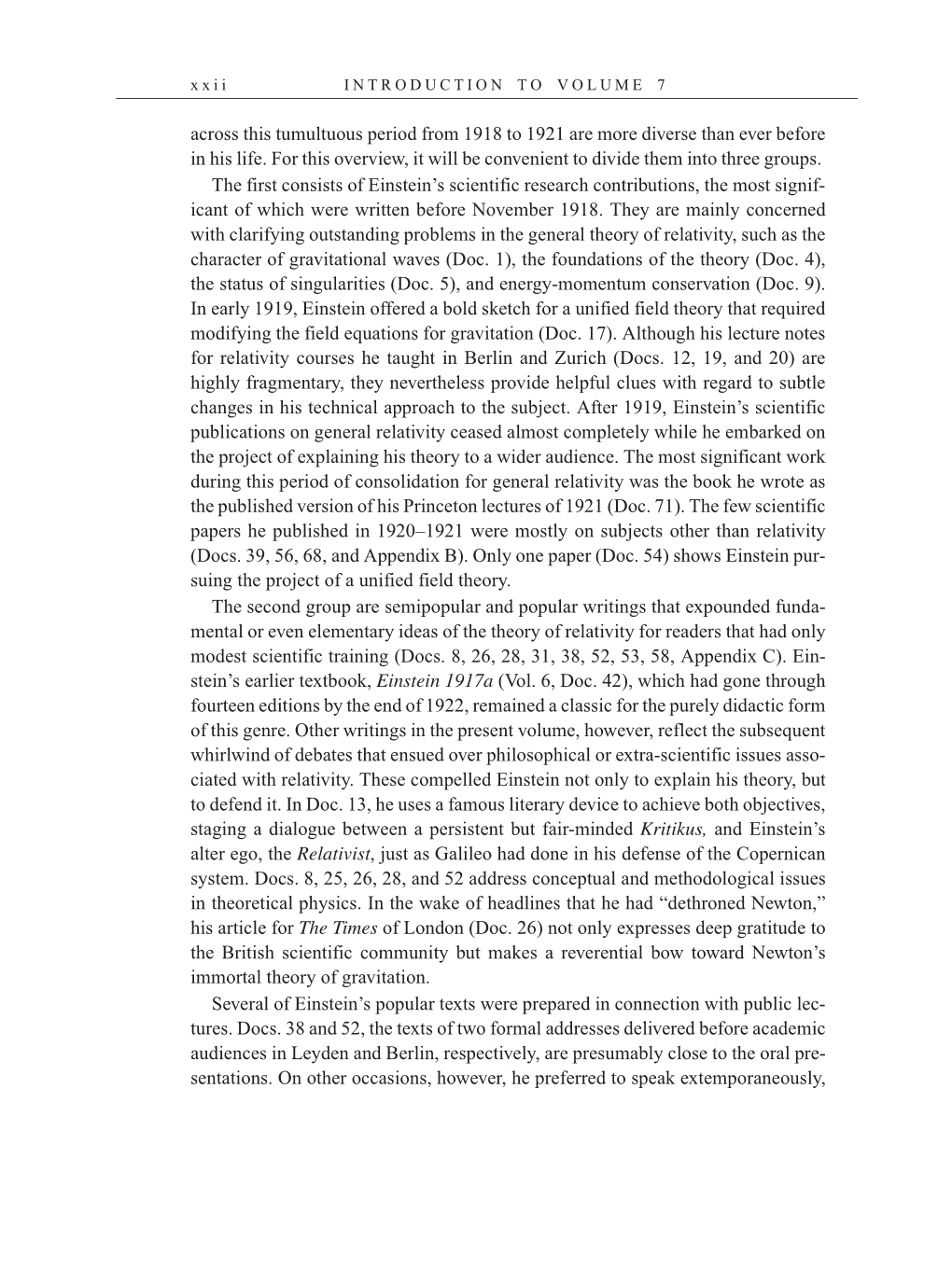x x i i I N T R O D U C T I O N T O V O L U M E 7
across this tumultuous period from 1918 to 1921 are more diverse than ever before
in his life. For this overview, it will be convenient to divide them into three groups.
The first consists of Einstein’s scientific research contributions, the most signif-
icant of which were written before November 1918. They are mainly concerned
with clarifying outstanding problems in the general theory of relativity, such as the
character of gravitational waves (Doc. 1), the foundations of the theory (Doc. 4),
the status of singularities (Doc. 5), and energy-momentum conservation (Doc. 9).
In early 1919, Einstein offered a bold sketch for a unified field theory that required
modifying the field equations for gravitation (Doc. 17). Although his lecture notes
for relativity courses he taught in Berlin and Zurich (Docs. 12, 19, and 20) are
highly fragmentary, they nevertheless provide helpful clues with regard to subtle
changes in his technical approach to the subject. After 1919, Einstein’s scientific
publications on general relativity ceased almost completely while he embarked on
the project of explaining his theory to a wider audience. The most significant work
during this period of consolidation for general relativity was the book he wrote as
the published version of his Princeton lectures of 1921 (Doc. 71). The few scientific
papers he published in 1920–1921 were mostly on subjects other than relativity
(Docs. 39, 56, 68, and Appendix B). Only one paper (Doc. 54) shows Einstein pur-
suing the project of a unified field theory.
The second group are semipopular and popular writings that expounded funda-
mental or even elementary ideas of the theory of relativity for readers that had only
modest scientific training (Docs. 8, 26, 28, 31, 38, 52, 53, 58, Appendix C). Ein-
stein’s earlier textbook, Einstein 1917a (Vol. 6, Doc. 42), which had gone through
fourteen editions by the end of 1922, remained a classic for the purely didactic form
of this genre. Other writings in the present volume, however, reflect the subsequent
whirlwind of debates that ensued over philosophical or extra-scientific issues asso-
ciated with relativity. These compelled Einstein not only to explain his theory, but
to defend it. In Doc. 13, he uses a famous literary device to achieve both objectives,
staging a dialogue between a persistent but fair-minded Kritikus, and Einstein’s
alter ego, the Relativist, just as Galileo had done in his defense of the Copernican
system. Docs. 8, 25, 26, 28, and 52 address conceptual and methodological issues
in theoretical physics. In the wake of headlines that he had “dethroned Newton,”
his article for The Times of London (Doc. 26) not only expresses deep gratitude to
the British scientific community but makes a reverential bow toward Newton’s
immortal theory of gravitation.
Several of Einstein’s popular texts were prepared in connection with public lec-
tures. Docs. 38 and 52, the texts of two formal addresses delivered before academic
audiences in Leyden and Berlin, respectively, are presumably close to the oral pre-
sentations. On other occasions, however, he preferred to speak extemporaneously,
